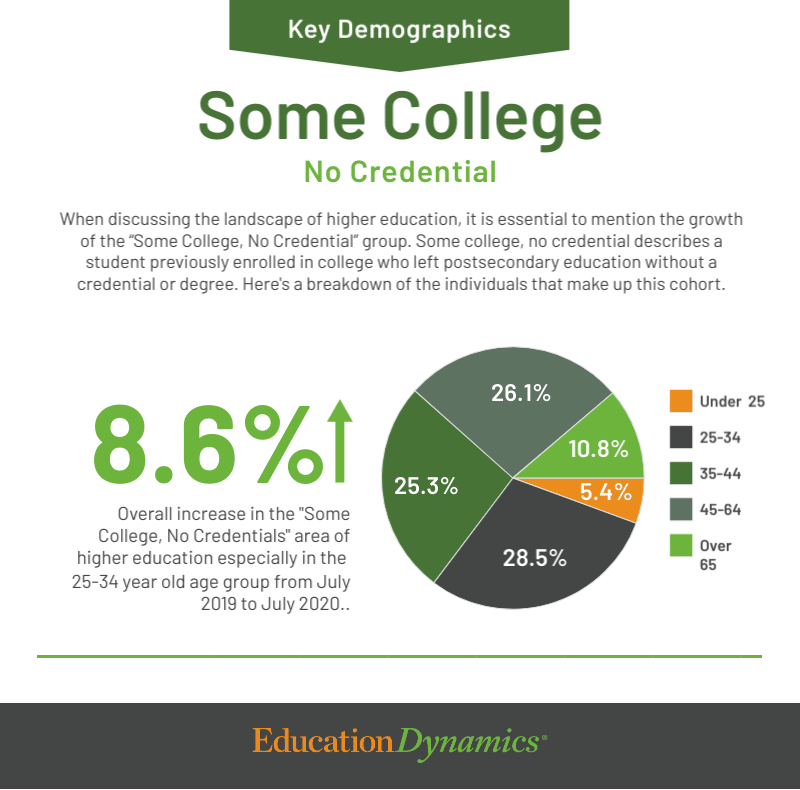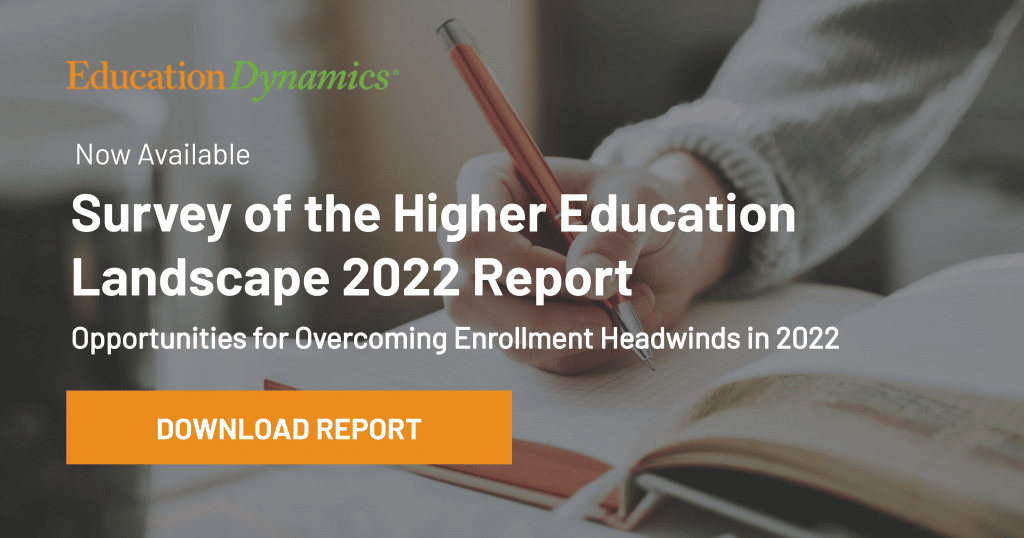Survey of the Higher Ed Landscape 2022

Opportunities for Overcoming Enrollment Headwinds in 2022
As institutions head into the third year of classes during the pandemic, they are doing so amid growing concerns about how the labor market and lifestyles impact enrollments. The message of the looming threat of declining birth rates, inflation, unstable labor marketing, and enrollment throughout the U.S. has been widespread.
Higher ed leaders are burdened with an overload of data. Institutions can’t be expected to sift every survey about enrollment trends or insight into student behavior. If you’re looking for another rehashed article about how “students are leaving college because they don’t want to pay back loans” or “they’re pursuing other careers because they can’t find jobs in their field,” this is not it! The stakes are high when deciding what actions to take.
While there are many challenges, there’s more excitement to be had about the opportunities to serve prospective students. In EducationDynamics’ latest report, Survey of the Higher Education Landscape 2022 – Opportunities for Overcoming Enrollment Headwinds in 2022, we highlight key areas we believe indicate opportunities in the future.
An Overlooked Population of Some College/No Credential Students Has Come to the Fore.
If you were a student three years ago, you might have just started taking classes. But suddenly, faced with health challenges, finances, or family commitments, you put your education on hold. An opportunity to join the workforce appears, and you take it because the burdens of earning your degree and managing all those stressors become too much to bear.
Many Americans have fallen under this condition since the start of the pandemic. From July 2019 to July 2020, students with some college and no credential increased by 8.6%. While many students are completing their degrees, they are finding themselves in a position where they’ve stopped out and could use some help getting back on track with their education. And, this was already a big subset of the population before the pandemic.
The potential to re-engage students likely to re-enroll is most robust within this group over those who immediately entered the workforce. The “Some College, No Credential” population is a massive audience ready to be served. The success of re-engaging the needs of these students depends on the efforts of marketing and enrollment staff to have regular contact with students, even after they stop out.

Unemployment Rates Have Dropped Across the Board Among All Education Levels
Remember back in 2008, the unemployment rate was high, and there were very few job openings? You may have been able to find a job in another industry or have decided to go back to school. This increase in enrollment, in a world with uncertainties, provided some relief for a short while.
The pandemic marked a series of disruptions where unemployment was high, and still, many chose not to enroll. Fortunately, it looks like the labor market is starting to heal. The number of unemployed and the unemployment rate saw a decline beginning in 2021. But, unemployment rates did not fall equally for all. The higher the degree, the less those workers were impacted. While employment has increased amongst the educated, those with some college, no bachelor’s degree were more affected between 2019-2021, indicating more volatility amongst this group than those with a bachelor’s degree or higher.
The takeaways here are that unemployment dropped to 3.6%, which is on par with the pre-pandemic levels, and now people are starting to feel comfortable enough to change careers or go back to school. This trend marks the beginning of the market getting back into balance and offers some hope for growth opportunities, especially for those seeking to return to school.
Higher Educational Attainment Provides Stability in an Unstable Job Market
Workers with higher degrees or credentials are taking advantage of the market. The pandemic brought about disproportionate labor force trends like the growth of the labor market and increases in job changes and quit rates. We see positive movement in the labor market regarding educational attainment based on current trends.
Those with bachelor’s degrees or higher were less impacted by layoffs and unemployment. Professional degrees are anticipated to experience the most significant employment increase (13.6%), followed by the doctoral degree (9.1%). These trends show that some demographic groups, including Hispanic and Black workers and less educated people, are still experiencing instability in the job market, while people with more education are less likely to change jobs.
Rising educational attainment is a leading factor in decreased unemployment and would mean positives for the future. If the goal is to increase stability and provide access to higher education, then colleges and universities will want to focus on those with some college, and no credential.
While There Was a Decline in Job Openings, the Labor Market Supports a Demand for Careers in Certain Sectors.
This trend shows that there is still a demand for skilled and trained labor. In response to the pandemic, many businesses had to downsize because they weren’t considered essential. The retail industry was impacted the most, with a 343,000 decline in job openings compared to the previous year. On the other hand, there was a dramatic increase in frontline workers who received extra incentives to continue working through the pandemic. We continue to see increases in the healthcare and social assistance sector, growing by 79,000 job openings in June.
The emergence of this trend has been one of the most important developments of the last couple of years. We expect to see program and credential offerings that take advantage of the labor market demand. Continuous monitoring of the labor market and student behavior will help institutions look forward and align their program offerings strategically as students evolve their plans.
This is by no means an exhaustive list of trends we’ve identified in our report. Higher education and students are entering a standout period of transition. Many Americans are experiencing social and economic factors prompting them to change their plans. As the landscape of higher education becomes increasingly complex and competitive, the most successful schools will understand the landscape and adapt their approach accordingly. The key to meeting enrollment and retention goals is how they choose to pivot.
Interested in viewing the report’s full findings? Download the Survey of the Higher Ed Landscape and learn more about adult and non-traditional student enrollment trends.
EducationDynamics is the industry leader in helping colleges and universities achieve their enrollment goals through the company’s unique ability to find the highest quality adult student prospects. As the trusted partner to more than 500 higher educational institutions, EducationDynamics has earned a reputation for providing the resources and expertise required to meet a wide range of industry challenges, delivering inquiry generation and agency of record marketing (e.g. paid digital, organic search, awareness), enrollment management, retention, and technology solutions to universities across the country. For more information, connect with our experts.
